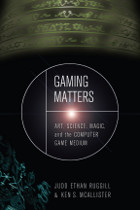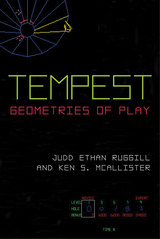2 books about Ruggill, Judd Ethan

Gaming Matters
Art, Science, Magic, and the Computer Game Medium
Judd Ethan Ruggill and Ken S. McAllister
University of Alabama Press, 2011
In his 2004 book Game Work, Ken S. McAllister proposed a rigorous critical methodology for the discussion of the “video game complex”—the games themselves, their players, the industry that produces them, and those who review and market them. Games, McAllister demonstrated, are viewed and discussed very differently by different factions: as an economic force, as narrative texts, as a facet of popular culture, as a psychological playground, as an ethical and moral force, even as a tool for military training.
In Gaming Matters, McAllister and coauthor Judd Ruggill turn from the broader discussion of video game rhetoric to study the video game itself as a medium and the specific features that give rise to games as similar and yet diverse as Pong, Tomb Raider, and Halo. In short, what defines the computer game itself as a medium distinct from all others? Each chapter takes up a different fundamental characteristic of the medium. Games are:
• Idiosyncratic, and thus difficult to apprehend using the traditional tools of media study
• Irreconcilable, or complex to such a degree that developers, players, and scholars have contradictory ways of describing them
• Boring, and therefore obligated to constantly make demands
on players’ attention
• Anachronistic, or built on age-old tropes and forms of play
while ironically bound to the most advanced technologies
• Duplicitous, or dependent on truth-telling rhetoric even when they are about fictions, fantasies, or lies
• Work, or are often better understood as labor rather than play
• Alchemical, despite seeming all-too mechanical or predictable
Video games are now inarguably a major site of worldwide cultural production.
Gaming Matters will neither flatter game enthusiasts nor embolden game detractors in their assessments. But it will provide a vocabulary through which games can be discussed in academic settings and will create an important foundation for future academic discourse.
[more]

Tempest
Geometries of Play
Judd Ethan Ruggill and Ken S. McAllister
University of Michigan Press, 2015
Atari’s 1981 arcade hit Tempest was a “tube shooter” built around glowing, vector-based geometric shapes. Among its many important contributions to both game and cultural history, Tempest was one of the first commercial titles to allow players to choose the game’s initial play difficulty (a system Atari dubbed “SkillStep”), a feature that has since became standard for games of all types. Tempest was also one of the most aesthetically impactful games of the twentieth century, lending its crisp, vector aesthetic to many subsequent movies, television shows, and video games. In this book, Ruggill and McAllister enumerate and analyze Tempest’s landmark qualities, exploring the game’s aesthetics, development context, and connections to and impact on video game history and culture. By describing the game in technical, historical, and ludic detail, they unpack the game’s latent and manifest audio-visual iconography and the ideological meanings this iconography evokes.
[more]
READERS
Browse our collection.
PUBLISHERS
See BiblioVault's publisher services.
STUDENT SERVICES
Files for college accessibility offices.
UChicago Accessibility Resources
home | accessibility | search | about | contact us
BiblioVault ® 2001 - 2024
The University of Chicago Press









